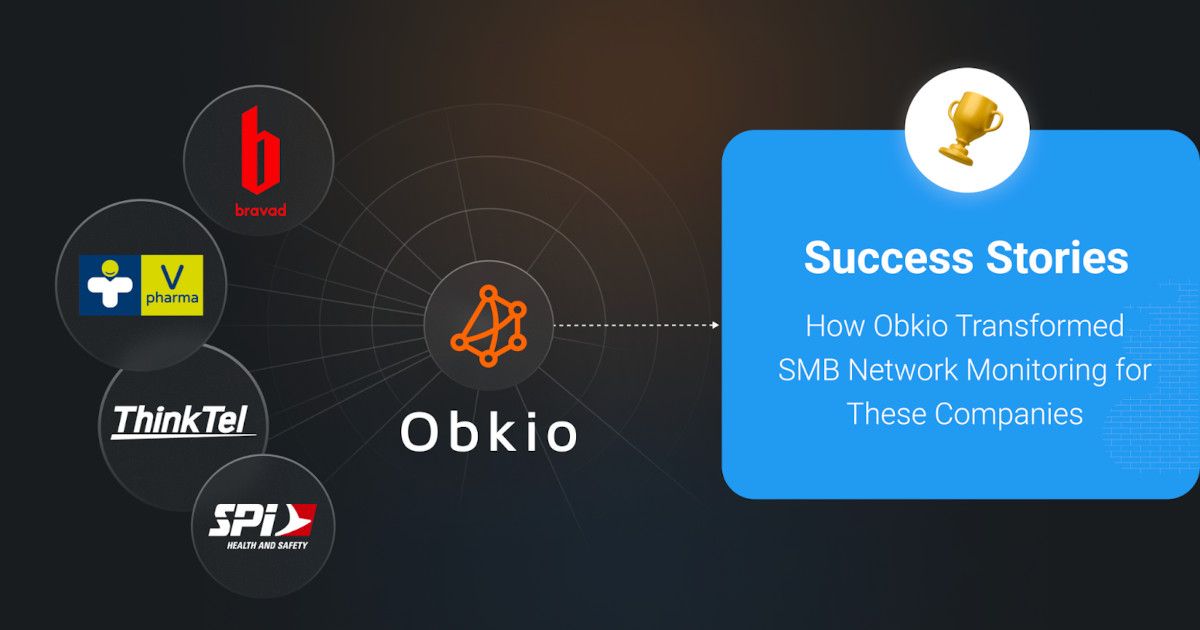Table of Contents
Table of Contents
In the battleground of modern business, your enterprise network is the backbone, and trust me, keeping it in top-notch shape is non-negotiable.
Your network is like a Spartan soldier, charging into the chaos of the IT battlefield. But even Spartans need their shields, right? That's where Enterprise Network Monitoring comes in – it's your shield against network slowdowns & bottlenecks, security breaches, and those random performance hiccups.
In this article, we'll be talking about why it's not just a tech whim but a strategic necessity. So, buckle up, because by the end of this journey, you'll be the Leonidas of network resilience, leading your enterprise to glory!
Enterprise network monitoring is like your GPS, but cooler. It's the tech-savvy co-pilot navigating you through the twists and turns of your network's performance.
Enterprise network monitoring stands as a pivotal IT procedure, overseeing the health and efficiency of all network elements, including routers, switches, firewalls, servers, and virtual machines (VMs). This comprehensive and strategic approach to monitoring, troubleshooting, and optimizing the performance, reliability, and security of computer networks within large-scale organizations goes beyond just network devices.
The vast and complex network infrastructure of such organizations demands a nuanced approach to swiftly distinguish between internal (LAN) and external (WAN) issues. Rapid identification ensures not only the optimization of network performance but also the efficient allocation of resources. Troubleshooting efforts can then be promptly directed to the appropriate teams, streamlining workflow and minimizing confusion among various departments.
Why should you care? Well, because in the digital age, your network isn't just a bunch of cables and routers, it's the lifeline of your business. Enterprise network performance monitoring ensures it stays in peak condition, ready to tackle whatever challenges the online world throws your way.
Network Monitoring isn't just about making your IT guy's life easier. It's about keeping your business in the fast lane to success.
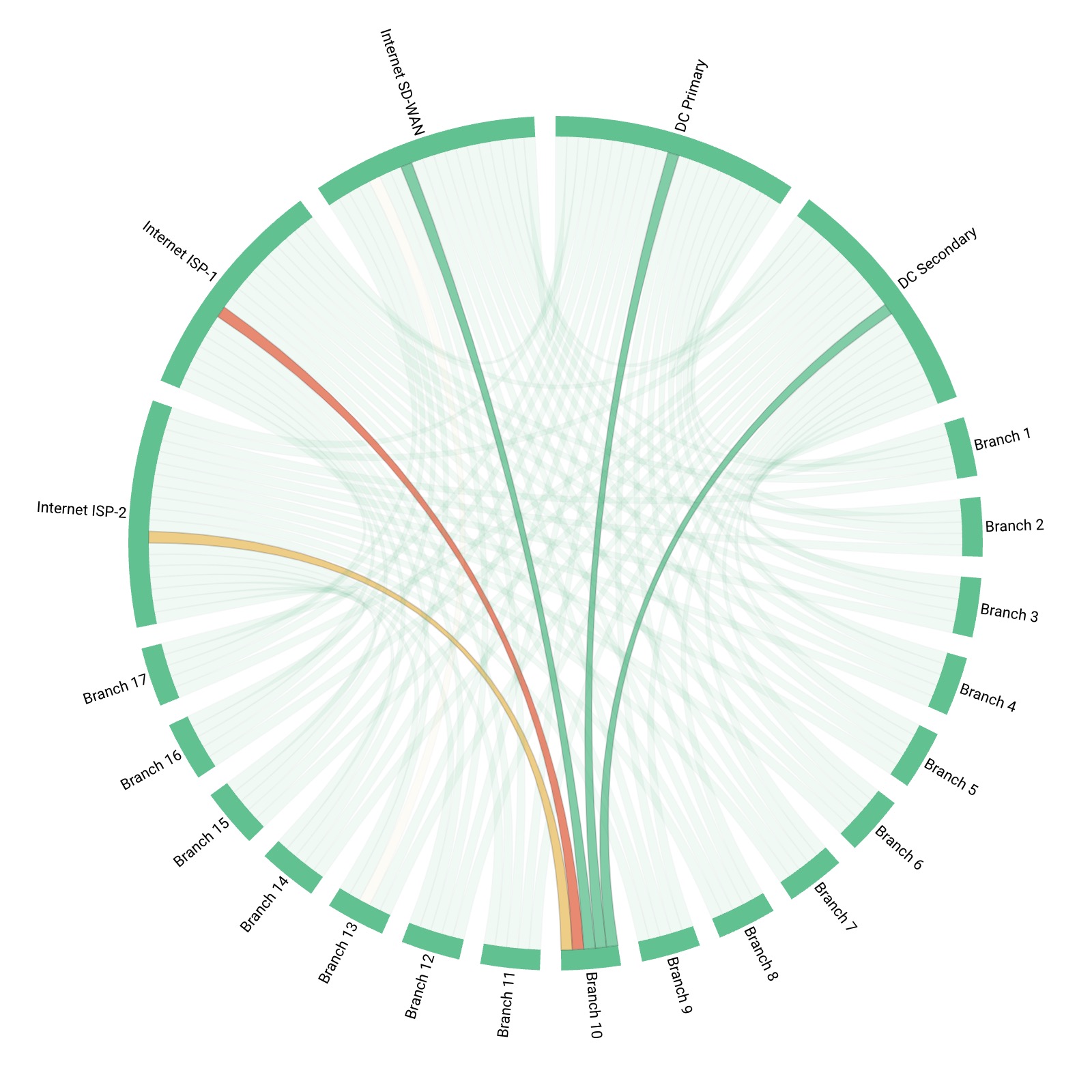

It’s worth mentioning that enterprise network monitoring and small-to-medium business (SMB) network monitoring share the common goal of ensuring optimal performance, availability, and security of computer networks. However, these approaches differ significantly in scale, complexity, and specific requirements.
- Scale and Complexity: Enterprises operate on a grander scale with a more intricate network infrastructure compared to SMBs. The sheer size and complexity of an enterprise network demand a robust monitoring solution capable of handling a multitude of devices, locations, and users.
- Need for Growth and Flexibility: Enterprises are dynamic entities with evolving needs. Unlike SMBs which may have more static requirements, enterprises demand network monitoring solutions that can scale and adapt to the changing landscape of their network infrastructure. Flexibility is key to accommodate growth, technological advancements, and shifts in business operations.
- Number of Network Devices: Enterprises typically manage a vast array of network devices, including routers, switches, firewalls, servers, and virtual machines. The monitoring solution for enterprises must have the capacity to handle and analyze data from these diverse devices comprehensively.
- Number of Users: The user base in an enterprise is often extensive, and distributed across various departments and locations. Effective enterprise network monitoring should provide insights into user experience, ensuring optimal connectivity and performance for all individuals interacting with the network.
- Number of Network Locations to Monitor (Distributed Monitoring): Enterprises frequently operate across multiple locations, making distributed monitoring a necessity. A centralized monitoring approach may not suffice for a large-scale enterprise. The solution should efficiently collect and analyze data from various locations, providing a holistic view of the entire network.
With its array of metrics and performance tests, network monitoring is just as important to top managers and business owners as sales numbers because it has a direct bearing on your company's financial health.
How?
A startling number from Gartner should grab the interest of all those making decisions for the company: for 98% of enterprises, even one hour of downtime can cost more than $100,000 in lost revenue. If that isn't reason enough to worry, an astounding 81% of respondents stress that the hourly cost increases to $300,000 or more.
Let's now convert these figures into impact-related terminology. Not only is there a waste of time, but there are also financial losses, decreased returns on investment, breaches of security, and data loss. This is a warning to decision-makers, not just a statistic. Neglecting network monitoring is not only a risky move, but it also puts you at risk of financial ruin. Not whether you can afford to buy network monitoring tools, but rather whether you can afford not to, is the question.
According to the Digital Enterprise Journal (DEJ), 58% of enterprises stated that monitoring IT performance from the viewpoint of users is now a strategic goal. Moreover, top-performing companies prioritize customer experience 2.2 times more often than other organizations in their IT initiatives.
Keeping the digital engine running is what matters most to you. Not only is it important to reduce downtime, but you also need to perform a full network audit, troubleshoot your network, avoid interruptions, secure fast connection for all remote workers, and make sure your services live up to consumer expectations.
You are the designers of a smooth digital experience for all parties involved, not just someone who keeps the lights on. Now let's explore how enterprise network performance monitoring affects your world:
1. Monitoring Your Network's Health with Audits and Assessments
It is as vital to look forward as it is to look back. Admins carefully monitor availability, latency, throughput, usage, and error rate among other crucial metrics to provide a comprehensive view of the network's health. This is not just a list of facts, it's a strategic path. Imagine having a comprehensive network assessment before launching a major service deployment or migration, such as moving from MPLS to SD-WAN or deploying VoIP and UC. It's about anticipatory perceptions that help you avoid possible hazards.
2. Use Proactive Troubleshooting to Solve Network Problems
Analyzing metrics like packet loss, speed, and latency in real-time, it makes network troubleshooting less complicated and more streamlined. Imagine having precise timestamps of when it occurred, forensic knowledge of the reason, instant access to the issue's location on the LAN or WAN, and a clear idea of who is accountable for troubleshooting it. It's not just about identifying difficulties, it's also about responding to problems faster when they occur.
3. Real-Time Enterprise Network Monitoring to Ensure Maximum Efficiency
When it comes to VoIP quality, cloud applications, SD-WAN networks, MPLS networks, SASE networks, unified communication apps (like Zoom and Microsoft Teams), and more, real-time visibility is crucial to your everyday operations. Your surveillance is continuous observation, which recognizes and assesses issues before they become serious ones. It is the cornerstone of a network's health, ensuring that every component – from WiFi and the Internet to SaaS applications and network devices – is working at peak performance.
Now, let's shine a light on the hurdles you might face when diving into the world of enterprise network monitoring. It's not all rainbows and unicorns, but understanding these challenges is the first step to conquering them.
1. Scale and Complexity:
Imagine your network as a bustling city – the more it grows, the trickier it gets to keep tabs on every nook and cranny. Enterprise networks are constantly expanding with numerous devices and connections. We'll explore strategies to tackle this vastness and ensure no digital corner goes unwatched.
2. Data Overload:
In the world of network monitoring, information is power. But too much data? That can be overwhelming. Sorting through the sea of alerts and metrics to pinpoint what truly matters is an art. Enterprises, with their multitude of locations, services, and devices, often struggle to consolidate their most important network data into one centralized location. Even with distributed monitoring points, the challenge lies in sorting through the vast sea of alerts and metrics to pinpoint what truly matters. We'll discuss smart filtering and analysis techniques to turn your data into actionable insights.
3. Evolving Threat Landscape:
Cyber threats are shape-shifters, always evolving. Network monitoring must stay one step ahead. We'll delve into the challenges of keeping up with the latest threats, from sneaky malware to sophisticated hacking techniques, and how your monitoring strategy can adapt to safeguard your digital fortress.
4. User Experience Monitoring:
It's not just about the tech stuff. The user experience is the heartbeat of your network. But how do you monitor it effectively? From application performance to ensuring a seamless connection for end-users, the challenge is to keep everyone in your digital realm happy and productive.
The biggest challenge lies in identifying the root origin of network issues, which can arise from different parts of the network. This intricate dance of network performance evaluation requires a nuanced understanding and strategic monitoring.
The consequences of enterprise network problems include a range of negative effects, including:
Business Disruption: Network glitches can throw a wrench into your business operations, disrupting the smooth flow of activities and hindering productivity.
Financial Loss: Beyond operational disruptions, network issues can directly impact your bottom line, leading to revenue loss and financial setbacks.
Reputational Damage: A faltering network reflects poorly on your organization, potentially tarnishing its reputation. Clients and partners may lose confidence in your ability to deliver reliable services.
Compromise of Sensitive Data: Network vulnerabilities can expose sensitive customer data to unauthorized access, posing a significant threat to data security and compliance.
These network challenges encompass a spectrum of issues, including:
- Application Response Time: Delays in application response time can frustrate users and impede critical business processes.
- Device Failures: Malfunctions or failures of network devices can disrupt the overall network functionality.
- Link Failures: Interruptions in network links can lead to communication breakdowns between various components, affecting seamless data flow.
- Interface Issues: Problems at the interface level can cause disruptions in data exchange and compromise the efficiency of interconnected devices.
Here are some stats that support the many pitfalls that enterprises face nowadays.
90% of businesses prioritize the importance of their network because they recognize its important role in corporate operations. That said, it's alarming that a sizable 61% of network bottlenecks go unnoticed and are not discovered by IT/NetOps, according to a recent survey done among American enterprises.

This failure highlights the urgent need for reliable enterprise network monitoring software.

As you can see, there could be costly consequences if these drops in network performance are left unchecked. Thankfully, enterprises can prepare for situations like this, and preventive measures like using network monitoring software are crucial.
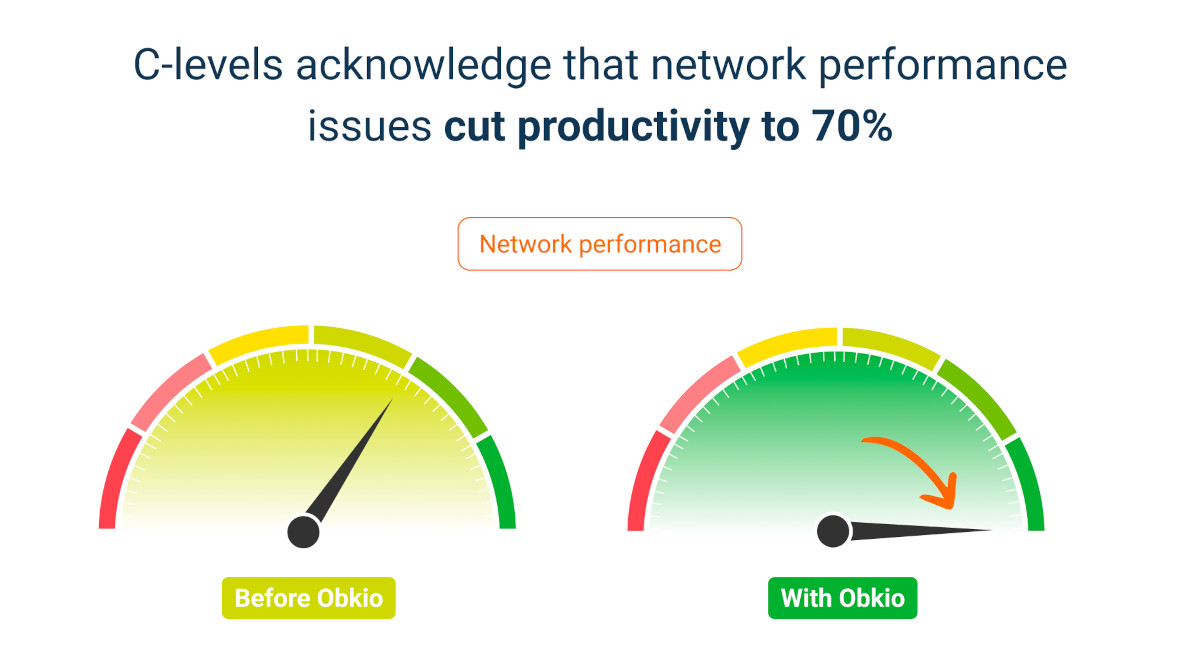
Obkio offers robust, user-friendly, and all-inclusive network monitoring solutions to businesses of all sizes across a range of sectors, including professional services, manufacturing, banking, and more. Our platform offers a number of network monitoring tools to help clients quickly detect, diagnose, and resolve network issues before they affect end users.
This is done by synthetic traffic generation by active monitoring agents, network path monitoring, cloud network monitoring, ensuring constant connectivity for all employees, making certain that critical apps run well, and much more.
Offering custom pricing plans specifically designed for Enterprise Customers, Obkio enables organizations to monitor as many network locations as needed. This flexibility ensures that enterprises, with their extensive and intricate network infrastructures, can efficiently manage and optimize performance across all their sites.
Obkio's strength lies not only in its adaptability to the diverse needs of large-scale enterprises but also in its user-friendly approach. The platform is simple to deploy and use, featuring an intuitive UI that requires minimal training.
Sounds like a perfect choice for you? Get started with Obkio for free!
- 14-day free trial of all premium features
- Deploy in just 10 minutes
- Monitor performance in all key network locations
- Measure real-time network metrics
- Identify and troubleshoot live network problems

Alright, we've pinpointed the challenges, now let's gear up and tackle them head-on. Navigating the landscape of enterprise network monitoring may seem daunting, but armed with the right strategies, you'll be the captain of your digital ship.
Scaling Solutions for Network Growth: As your enterprise network expands, so should your monitoring capabilities. We'll explore scalable solutions that evolve alongside your network, ensuring comprehensive coverage without drowning in the sea of devices and connections.
Smart Data Handling Techniques: Data overload is the nemesis of effective monitoring. We'll unravel techniques for intelligent data handling, from prioritizing critical alerts to implementing filters that sift through the noise, ensuring you focus on what truly matters.
User-Centric Monitoring: Your users are at the heart of your network. We'll delve into strategies for monitoring the user experience, ensuring seamless application performance and addressing interface issues promptly. Happy users mean a thriving digital ecosystem.
By adopting enterprise network monitoring solutions you can establish continuous network monitoring, rapid issue resolution, and sustained network performance 24/7. This arrangement eliminates the need for a full-time, in-house team, freeing up internal resources to concentrate on projects that contribute to revenue generation.
If you find yourself relying on outdated monitoring solutions and tools, your attention is likely confined to the fundamental health and metrics of your network. Unfortunately, this approach falls short of meeting the needs of your networking teams, especially in the context of a contemporary, cloud-driven, and distributed network ecosystem.
Every network team aspires to enhance the visibility of their network. Achieving greater visibility stands as a crucial cornerstone in crafting an effective network monitoring strategy.
With the help of these monitoring and alerting best practices, you can improve your enterprise network monitoring strategy, streamline your daily schedule, and guarantee the uninterrupted operation of your network infrastructure.
Here, we offer a concise overview of monitoring and alerting strategies, If you're eager for an in-depth exploration, we have a dedicated article that delves into every detail: Network Monitoring Best Practices.

In the realm of network monitoring, the initial decision on the type of monitoring tool sets the tone for efficiency and effectiveness. It's akin to selecting the right tool for a job, with each solution offering unique benefits.
1.1 Active vs. Passive Network Monitoring:
Choosing between active and passive network monitoring is crucial. Active monitoring involves intentional synthetic traffic generation, offering a proactive assessment. It's akin to having a proactive guard, swiftly raising alerts. Passive monitoring quietly observes network traffic without actively participating, providing non-intrusive insights. Understanding the nuances empowers network admins to deploy suitable tools for their specific needs.
What is the Best Practice?
Start by evaluating different monitoring techniques and identify 3 to 5 vendors capable of meeting your network's needs. Consider factors like scalability, flexibility, integration capabilities, and real-time monitoring features. For a detailed guide, explore our article on Active vs. Passive Network Monitoring.
1.2 Centralized vs. Decentralized Network Monitoring:
The architecture of your network, whether centralized or decentralized, influences monitoring methods. Centralized networks concentrate control in a central hub, facing vulnerability to single points of failure. Decentralized networks disperse resources, offering redundancy and fault tolerance.
With numerous distributed locations, remote users, and data centers operating independently, the need for decentralized network monitoring is more crucial than ever. Enterprises grapple with the challenge of ensuring optimal performance between devices across various locations, and decentralized monitoring emerges as the strategic solution.
However, recognizing the significance of both decentralization and centralized analysis, the optimal approach involves a hybrid model. A decentralized network monitoring strategy is implemented at individual locations, ensuring real-time visibility and rapid issue identification. Simultaneously, a centralized hub serves as the focal point for collecting and analyzing data from all distributed monitoring points.
The best practice involves evaluating your network's structure and specific requirements before making a decision.
What is the Best Practice?
Thoroughly evaluate your network's structure and requirements, ensuring seamless integration with the chosen monitoring tool. Learn from fellow administrators in similar structures, explore customer feedback, and gather references to inform your decision-making process.

In the dynamic landscape of network administration, physically overseeing every network component at all times is a daunting task. Enterprise network monitoring tools, acting as the vigilant eyes and ears of the network, deliver real-time insights into its performance and health.
At the heart of this comprehensive monitoring strategy are Monitoring Agents, strategically deployed in every network location. These agents play a pivotal role in continuously exchanging synthetic data to monitor performance, ensuring that administrators can keep a vigilant eye on every aspect of the network, even in locations where physical IT staff might not be present.
Moreover, the flexibility to easily deploy additional agents with every new location ensures scalability and adaptability as the network expands.
Extending Oversight with Monitoring Agents
These agents are indispensable, extending administrators' reach across the entire network:
- Identify potential bottlenecks and optimize data transmission from LAN to WAN for efficient connectivity.
- Utilize SNMP to monitor the health and performance of critical network devices, enabling proactive maintenance and swift issue resolution.
- For VoIP and UC, track metrics like latency, call quality, and MOS score, ensuring seamless communication.
- In ERP and CRM, monitor data transfer times and application responsiveness for optimal business process management.
- Ensure secure interactions with Cloud Services by tracking and identifying anomalies that could indicate potential security threats.
Active or proactive monitoring, also known as synthetic monitoring, involves simulating user activity within a network to assess application and network performance. By replicating synthetic traffic that mirrors actual user and application behaviours, network admins can pinpoint and troubleshoot potential network problems before they impact users.
Advantages of Proactive Monitoring:
- Addressing network issues proactively reduces the impact on user experience and workload for customer support.
- Minimizes network downtime for network applications and services.
- Decreases the load on network resources, contributing to cost efficiency and streamlined network management.
- Wide-ranging applications, including monitoring websites, web & mobile applications, APIs, 3rd-party software, microservices, CDNs, and DNSs.
Synthetic monitoring emerges as a superior option for businesses addressing data privacy and security concerns. By identifying issues before impacting real users, administrators can implement preventive measures, ensuring consistent connectivity and a low risk of network disruptions.
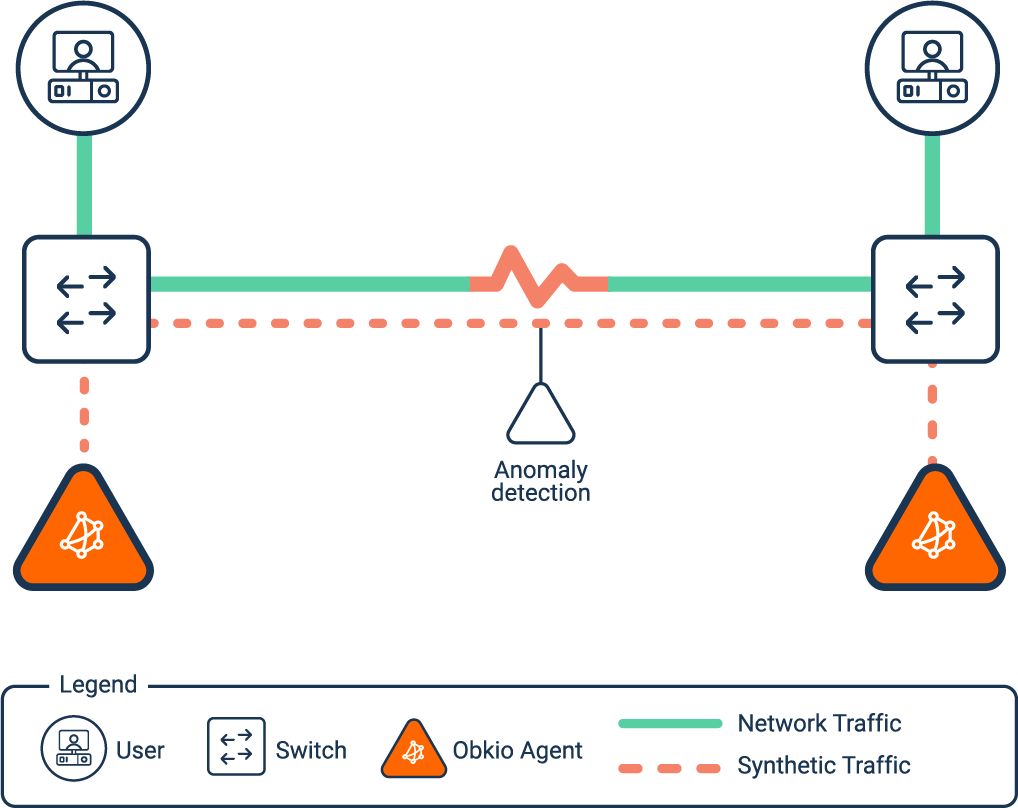
Traditional tools act like drop towers, offering a limited and brief view of your network's overall status. While they may indicate if the network is operational, nuances of performance remain concealed.

Modern network monitoring software like Obkio provides the Ferris wheel experience. It takes you on a thrilling ride, offering a detailed, dynamic, and real-time perspective of your network's performance.
Go beyond basics with critical metrics:
- Latency: The delay in data movement between nodes in a network.
- Jitter: Fluctuations in packet arrival time delays throughout a network.
- Packet Loss: The drop of data packets during transport, preventing them from reaching their intended destination.
If your current solution lacks comprehensive monitoring of these and many other metrics, it's akin to chasing a departed train. Consider switching to a vendor aligned with network monitoring best practices.
Understanding what's normal for your network, its typical behaviour, and the crucial data points forms the groundwork. This understanding gives birth to a baseline, a benchmark for your network's ideal performance.
A network baseline acts as the gold standard, defining the norm for your network's optimal performance.
It's not just about recognizing good performance but also identifying deviations.
Advantages of this Best Practice:
- A clear baseline allows precise alert threshold setting, enabling timely identification and resolution of potential issues.
- Historical performance data aids in anticipating future needs, and supporting strategic decisions for network optimization.
- Setting a baseline involves various network events, offering a comprehensive view of proactive measures.
As networks evolve in complexity, effective monitoring and alerting are critical for NetOps. The sheer magnitude of activity within enterprise networks can potentially generate a multitude of network monitoring alerts, making it crucial to implement a strategic approach to alert management. Make sure to set thresholds for actionable alerts that matter most.
Focus on the vital components by implementing the 80/20 rule, directing attention to the 20% of metrics likely to impact 80% of performance.
Advantages of this Best Practice:
- Concentrate on vital elements, ensuring crucial events receive prompt attention.
- Prevent alert fatigue, leading to a more efficient response to genuine issues.
- Efficient resource allocation directs efforts where they are most needed, streamlining proactive network management.

For effective network performance monitoring, constructing a powerful network monitoring dashboard is indispensable. This entails choosing key metrics, organizing them logically, and tailoring the dashboard to align with the organization's unique needs and priorities.
Advantages of this Best Practice:
- A well-crafted dashboard provides instant visibility into crucial network metrics, allowing network administrators to swiftly assess performance and identify potential issues.
- Preventing information overload ensures that essential insights are easily accessible.
- Enhancing clarity with straightforward visualizations like line charts, bar charts, or gauges prevents dashboard clutter.
- Integrating widgets or KPIs offers quick insights into critical network metrics.
- Embedding contextual alerts within visualizations highlights anomalies or crucial events.
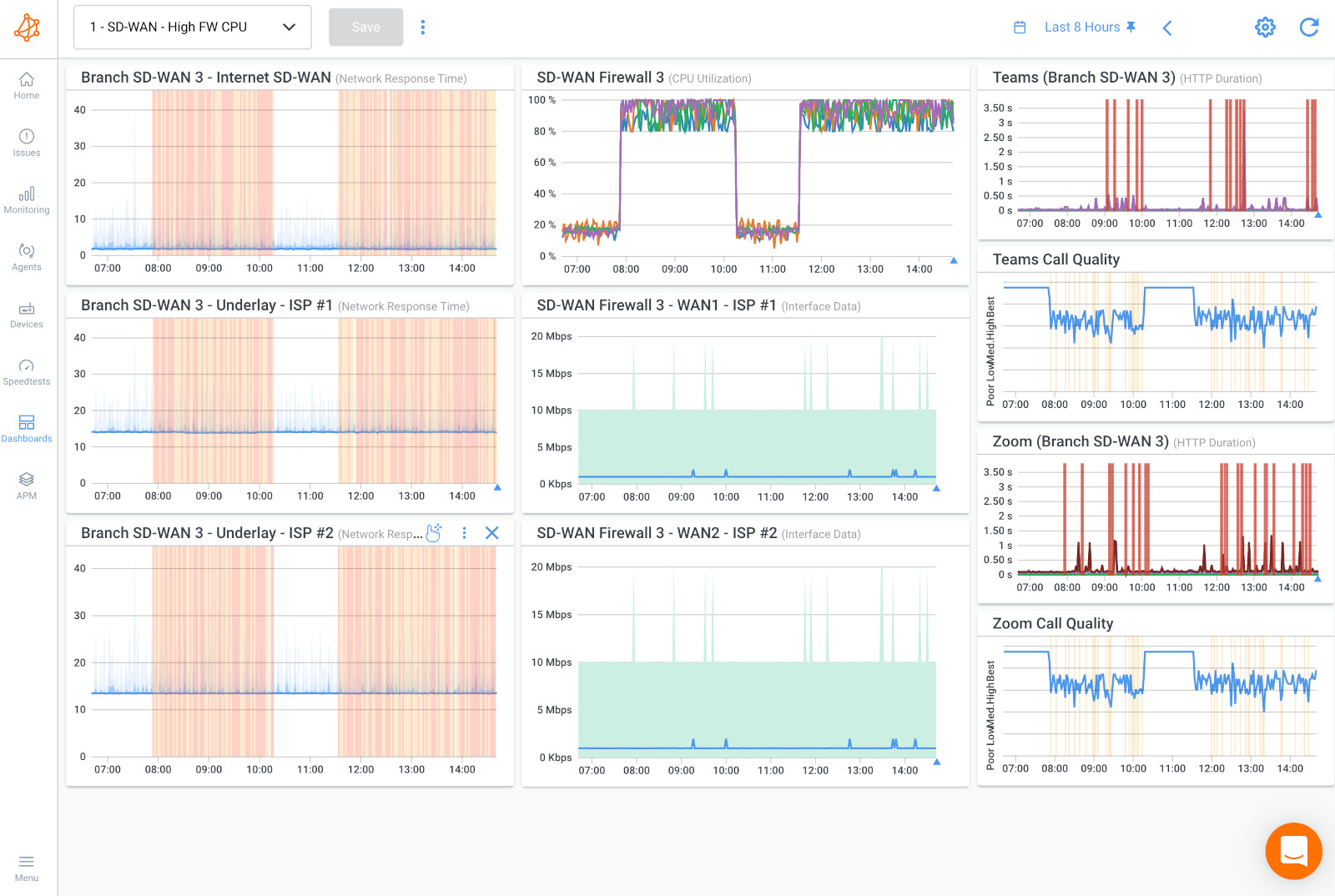
Enterprise Network Monitoring Best Practice #8: Distinguish Between Internal (LAN) and External (WAN) Network Issues
A pivotal aspect of effective network troubleshooting is the rapid identification of internal (LAN) versus external (WAN) issues. This differentiation is critical for precisely pinpointing the problem's source and involving the right personnel in the resolution process.
Consider Two Scenarios:
1. LAN Issue:
- Example: The router at the office is unresponsive due to outdated settings, requiring a forced update.
- Resolution: Internal teams collaborate to troubleshoot, with you taking the lead to resolve the issue.
2. WAN Glitch:
- Example: Evidence, such as high packet loss identified through a traceroute tool, points to an issue with the ISP.
- Resolution: Escalate the support case and ensure a prompt resolution with the service provider.
Advantages of this Best Practice:
- Swift identification allows efficient resource allocation.
- Troubleshooting efforts are directed to the appropriate team promptly, optimizing workflow and minimizing confusion among teams.
Now that you have these network monitoring best practices at your disposal, the power is yours! Take control of your network's health, solve problems before they arise, and implement effective network monitoring strategies without delay.
Adopting these strategies can help you enhance customer satisfaction, boost income, streamline operational procedures, and optimize network performance.
Effective enterprise network monitoring essentially follows the principle "Monitor Enterprise Network Performance Now, Not Later". Obkio's enterprise network monitoring software is your best bet for putting this into practice.
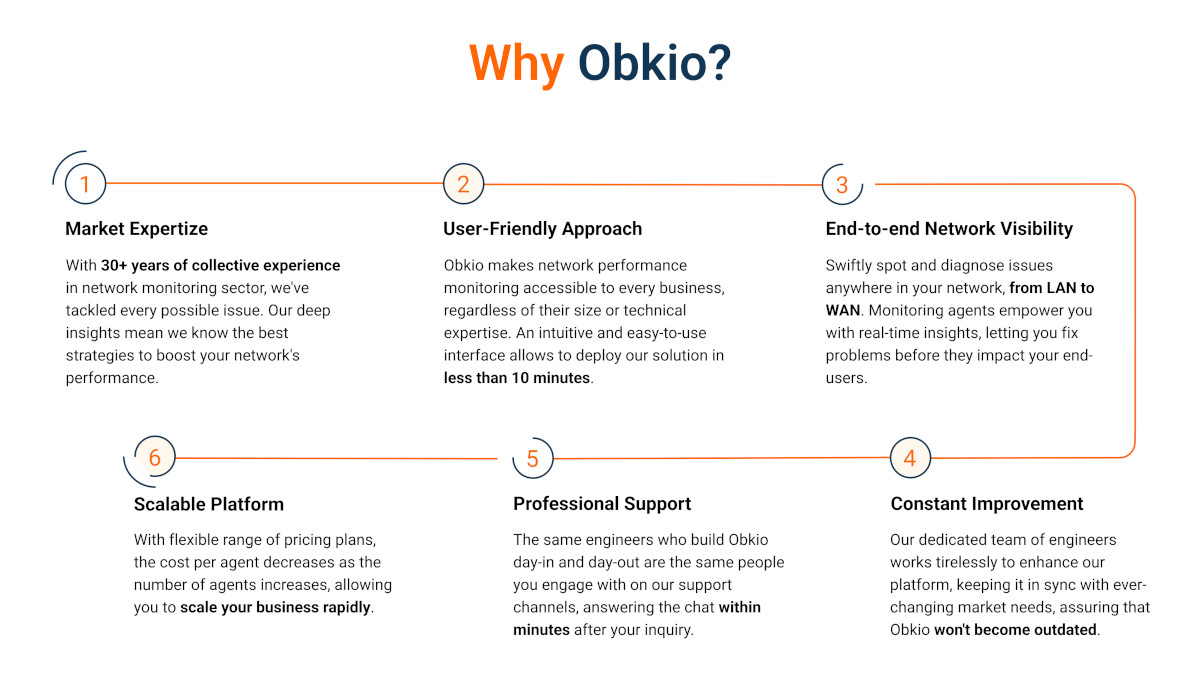
Are you prepared to improve the way you monitor networks?

Before Selecting an Enterprise Network Monitoring Solution, Consider These 10 Questions for Yourself
1. Is my company trying to achieve a certain network performance goal?
Establish performance targets to customize your monitoring strategy and keep ahead of emerging trends or common problems. Be flexible and frequently modify your goals to reflect changing circumstances.
2. Do network problems provide a problem?
With visual displays, network monitoring makes it easier to identify problems with the network. It gives you insight into how well network devices, apps, services, and other components are performing, enabling you to gather vital information and improve the effectiveness of troubleshooting.
3. Does network security concern your company?
Unexpected metric shifts may indicate possible dangers. A full perspective is provided by integrating monitoring with security solutions, which guarantees that your network remains protected.
To ensure that you don't overlook any blind spots, an end-to-end network monitoring strategy is usually the most effective. On the other hand, you have the option to limit the use of a network monitoring solution to the most important areas. Determine which areas of your network are most vulnerable to network bottlenecks or support your most critical apps or services.
5. To what extent is the setup simple?
A good network monitoring tool ought to operate without a hitch. Steer clear of standard enterprise network monitoring products' complicated setups or resource-draining alternatives that include functionality your company might not even require. Look into alternative options if it seems like a waste of important resources.
6. Does your system provide actionable alerts for enterprise network monitoring?
Alerts ought to provide information about what, where, and when in addition to being simple notifications. Timed and categorized alerts sharpen the focus and make sure you quickly become aware of important issues.
7. Is it possible to keep an eye on things remotely?
Characterized by their sheer size and complexity, the physical presence of IT staff in every location is impractical. The need for a robust and flexible network management solution becomes evident, emphasizing the importance of remote access capabilities. Make sure that your team can oversee and control the network from any location.
8. Can your network expand along with the network monitoring solution?
Choose for flexibility to adjust to shifting network environments and scalability to support expansion. Turn off monitoring when it's not required to maintain focus.
9. Is it simple to use the solution?
Select a structure that makes it easier to navigate and is user-friendly. An easy-to-use dashboard for network monitoring guarantees a lower learning curve for your team and more productivity all around.
10. How does value correspond with price?
Although significant, pricing levels shouldn't take precedence above efficacy. To choose a solution that really satisfies your demands, weigh features and pricing.
At Obkio, we understand the unique requirements of enterprise-scale networks, and our commitment goes beyond providing a one-size-fits-all pricing model. We recognize that each enterprise network is distinct, with specific complexities, demands, and objectives. Therefore, our approach is centred around flexibility.
We offer custom pricing plans designed to align seamlessly with the scale and intricacies of your network infrastructure. This means you get precisely what you need, without unnecessary costs or compromises.
If you've got the roadmap but find yourself lost in a sea of enterprise network monitoring tools, fear not! We've got the perfect solution tailored for your business. Say goodbye to the endless search and dive into effective network monitoring with ease.
Obkio caters to a diverse range of professionals and businesses, ensuring a seamless fit with your industry and organizational needs. Whether you're an IT professional, network administrator, decision-maker, or remote team lead, Obkio is designed to elevate your network monitoring experience.
Businesses that use Obkio:
- Small and Medium-sized Enterprises (SMEs)
- Managed Service Providers (MSPs)
- Enterprises with Complex Network Infrastructures
Network Types Covered:
- SD-WAN
- LAN/ WAN
- MPLS
- Dual-WAN
- WiFi
- Internet
- Distributed Networks
- VPN
- Internet Multihoming
Decentralized Monitoring Using Distributed Agents
These Agents span all network paths and are designed for seamless deployment in any environment. They operate in both directions, simulating a full-time network administrator conducting checks at every location.
Web & HTTP Application Performance Monitoring
It provides infinite tests and is simple to use. With continuous testing, APM Web imitates user behaviour by keeping an eye on SaaS, webpages, and other web services from the browser's point of view.
Synthetic Monitoring for Continuous Visibility
Sensitive information and actual traffic are not recorded using Obkio's technique. Using Monitoring Agents doing simulated tests, the system is intended to continuously assess performance, offer a historical baseline, and detect performance events that are above allowable thresholds.
Extensive Observation from WAN to LAN
Obtain complete visibility throughout. Regardless of the user's location (head office, remote branch, Starbucks, etc.) or the program or service they are using (VoIP, UC, ERP, CRM, Cloud), start with an overview and delve into comprehensive performance metrics.
Quick Network Analysis
The Chord Diagram, which offers a thorough snapshot of real-time network performance for each network path and is updated minute by minute, is the standout feature on Obkio's homepage. Start your investigation and review past performance information to verify if your network problem is a one-time event or a persistent one.
Effective Network Device Monitoring with SNMP
Using ultra-fast polling every 30 seconds, the app produces findings that are 10 times more accurate than those obtained with conventional 5-minute SNMP polling tools. When keeping an eye on network equipment like firewalls, routers, switches, and Wi-Fi access points, this targeted method is very helpful.
UC Communications Monitoring & Smooth VoIP
Quickly identify and resolve VoIP and UC application issues using Obkio. This covers apps like VoIP PBX, Microsoft Teams, and Zoom. We are able to monitor to the extent of assessing VoIP quality using the MOS Score. This makes it possible to identify performance issues early on, even during the breaks in between calls.
Tracking Firewall Effectiveness to Avoid Traffic Overload
Poor network performance brought on by ineffective firewalls is one of the most prevalent, yet frequently disregarded, issues. Through the establishment of a clear connection between the end-user experience and firewall resource utilization, Obkio's Network Monitoring tool provides a straightforward approach to potential issues.
It's now time to personally reap the rewards of Obkio’s enterprise network monitoring software. With just ten minutes of straightforward deployment, you can get going!
Obkio's end-to-end Network Monitoring SaaS service makes it easy to monitor both internal network performance and the connection with clients.

Disclosing Network Monitoring's Benefits:
Building Customer Trust: Increase customer trust by providing clear, up-to-date insights about your network as well as the networks of specific clients.
Proactive Issue Resolution: Keep a close eye on network performance and take quick action to address problems before they affect consumers. This will ensure that there are few disruptions and downtime.
Customized Insights: Display your dedication to your clients' success by tailoring monitoring reports to meet their particular needs.
Streamlined Operations: To do more with less work, reduce the amount of manual intervention, improve resource allocation, and streamline network administration.
Network and Internet performance is regularly monitored by monitoring agents, which are specialized software. Properly positioned, these Agents become the unsung heroes, quietly identifying problems with apps, the Internet, and platforms while causing no disruption to actual user activity.
They put in endless hours, simulating traffic exchanges every 500 ms while keeping an eye on network performance across many hubs, including branch offices, corporate headquarters, data centers, clouds, and the Internet. This distributed monitoring strategy, which is ideal for enterprises with numerous network locations, is a treasure trove of information, particularly in relation to client networks.
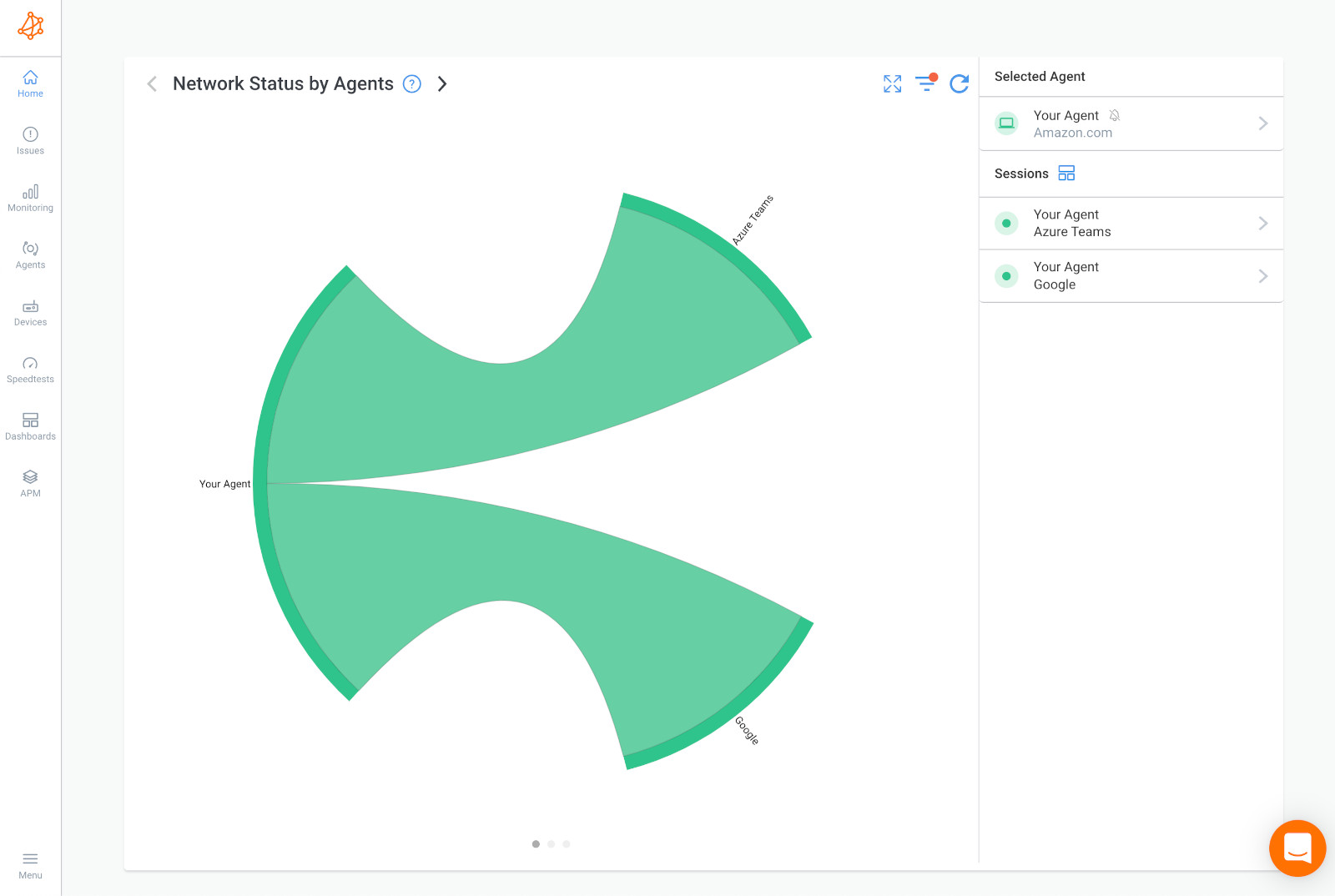
Monitoring your clients' networks is essential since your duties often go beyond managing your own network. Locate Monitoring Agents in every client network to take the initiative to improve performance and troubleshoot in the complex world of client networks.
Use Obkio as your go-to tool for seamless client network surveillance!
It's a great start to set up Monitoring Agents on your network as well as the networks of your clients. But hey, what do you know? It's not a one-time event; rather, it's a continuous conversation powered by synthetic traffic that improves your capacity to maximize network performance overall.
The Entire Performance Image:
- The key is synthetic monitoring, which offers a thorough understanding of network performance without interfering with actual user activity.
- Setting up a performance baseline (also referred to as thresholds) with alarms for quick issue identification and resolution is made possible by proactive issue detection.
- In addition to encouraging effective problem-solving, collaborative troubleshooting also ends the blame game.
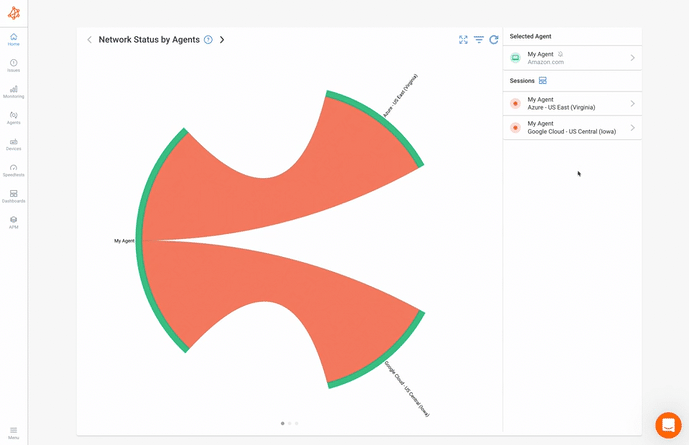

In the era of increased remote work, IT teams face the challenge of providing swift and efficient support for network issues. SPI Health and Safety, a Canadian leader in health and safety, found a tailored solution in Obkio for monitoring and troubleshooting the performance of their remote call center employees.
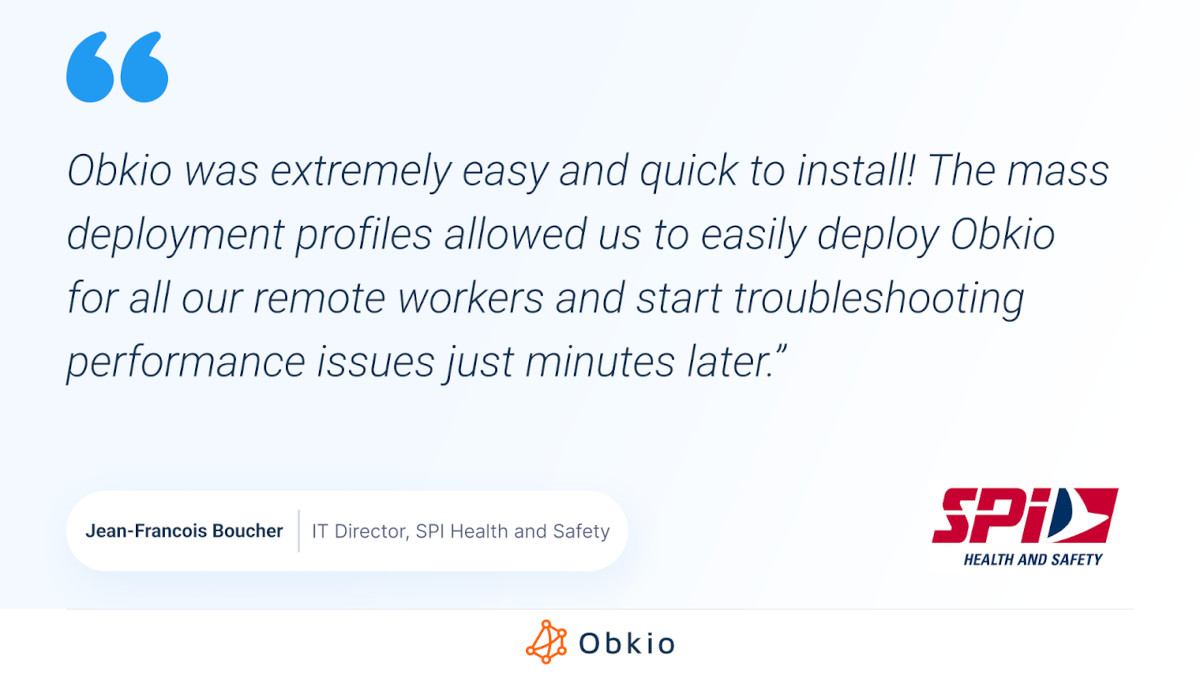
About SPI Health and Safety:
- Canadian leader in health and safety since 1972.
- Specializes in products, consulting services, and training.
- Transitioned call center employees to full-time remote work during the 2019 pandemic.
- Ensuring network and VoIP performance for remote call center workers.
- Initial complaints about poor VoIP Quality during support calls.
Adopting Obkio for Network Performance Monitoring:
- Deployed Obkio Network Monitoring Agents on each remote worker's workstation.
- Leveraged Obkio's Windows Agents for quick and easy setup.
- Used Deployment Profiles for mass deployment, ensuring rapid installation.
Custom Dashboards for Comprehensive Monitoring:
- Created custom dashboards to view network performance and MOS Score for every remote worker.
- Identified network problems before employees experienced them, thanks to detailed graphs.
Addressing User Complaints:
- Translated user feedback into measurable network metrics using Obkio.
- Collected data on VoIP Quality, jitter, bandwidth, latency, and packet loss
Identifying and Troubleshooting Issues:
- Used Obkio's data to pinpoint network problems in the user's local network or ISP network.
- Discovered and addressed WiFi-related issues remotely.
Proactive Call Routing:
- Automatic alerts and Obkio’s dashboard allowed proactive identification of performance problems.
- Enabled quick troubleshooting, optimization, and minimized downtime for call center employees.
Enhancing Customer and User Satisfaction:
- Continuous and proactive monitoring ensured a top-notch support experience.
- Reduced downtime for call center employees, leading to increased customer satisfaction.
- Simplified the IT team's job with enhanced visibility and quicker remote troubleshooting.
Continuous End-to-End Monitoring with Obkio:
SPI Health and Safety now has a comprehensive network monitoring solution for all their sites.
IT team has visibility over network issues for remote workers without requiring on-site support.
SPI Health and Safety's success with Obkio serves as a compelling case for other remote businesses seeking efficient and proactive network monitoring solutions. Start monitoring your remote network performance today with Obkio and ensure uninterrupted business operations.
Obkio is not just a tool, it's your partner in achieving unparalleled network visibility and performance. Let's elevate your network monitoring game together!



























 Obkio Blog
Obkio Blog






